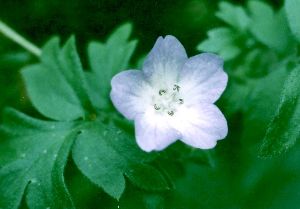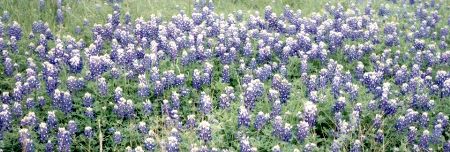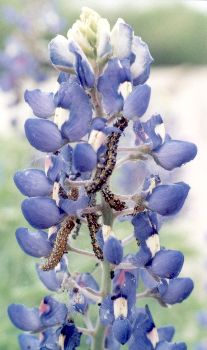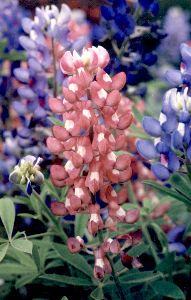|
There are three pretty little annuals that grow in great abundance everywhere but in our gardens. To get them to even germinate is a real challenge for me, but I keep trying since the flowers are nice. They are all delicate and can't take the heat of summer, dying before it gets too dry and hot.
 Pictured at left is baby blue-eyes (Nemophila phacelioides), a shade-loving woodland plant and, indeed, its genus name means just that. After trying to just broadcast the seeds in the winter, with no results, I had very good success with starting the seedlings in little cups, where I could give them water and keep the slugs off. Once a couple plants had grown large and produced loads of blossoms and seeds in our gardens, they seem to be established and have come back stronger each year. They bloom profusely until the temperature gets too high, then they die rapidly, having produced rather large seeds. Another name for this plant is large-flowered nemophila.
Pictured at left is baby blue-eyes (Nemophila phacelioides), a shade-loving woodland plant and, indeed, its genus name means just that. After trying to just broadcast the seeds in the winter, with no results, I had very good success with starting the seedlings in little cups, where I could give them water and keep the slugs off. Once a couple plants had grown large and produced loads of blossoms and seeds in our gardens, they seem to be established and have come back stronger each year. They bloom profusely until the temperature gets too high, then they die rapidly, having produced rather large seeds. Another name for this plant is large-flowered nemophila.

The second of this trio is blue-curls (Phacelia congesta), a member of the same Waterleaf Family (Hydrophyllaceae) as the baby blue-eyes. Blue-curls has several other names including phacelia, spider flower and wild heliotrope. Although it is supposed to be easy to grow, the seeds I sow never produce blossoming plants. The one time it grew in our garden was from a seedling bought at a nursery. After the temperatures got too high and everything started to bake, the plant died, so it goes in my category of tender plants needing too much attention. However, its buds and blossoms are very striking and it is nice to see in wild areas.
What Texas gardener hasn't tried to grow bluebonnets (Lupinus sp.) in their garden? As the last in this trio of short-lived, cool-weather annuals, the bluebonnet is certainly tempting to try to grow. Of the several species of bluebonnets, the ones commonly found around Austin are the Texas bluebonnet (Lupinus texensis). The little packages of seed that are sold rarely germinate, and when they do the plants struggle to bloom before the heat kills them. They seem to do best in rocky fields, the middle of dirt roads and along interstate highways. Of course, the blooms last for only a short time since the plants can't take the heat and drought. Because there are other, hardier, plants in all our gardens, the bluebonnets don't stand much of a chance.

 
In spite of my poor success rate, the lure of the bluebonnets is too strong and I frequently try to grow them. I put some seeds in little starter trays along with lots of other things and the bluebonnets took over two months to germinate, by which time I had planted other seeds in those "empty" places so the plants had some competition when they finally appeared. We have sometimes had bluebonnets come up from seed I just scattered and they were very pleasing for a short time. Too much of our garden space is now in shade for most of the year so earlier triumphs with bluebonnets are unlikely to be repeated. The best results come from transplanting tiny seedlings that sprout like weeds in a friend's yard. As the seeds germinate early in the winter, the young plants need the entire cool season in which to grow. They also need enough sun and water, and if conditions are not favorable, they grow poorly when spring arrives. As can be seen in the photo above at right, caterpillars don't respect the "hands off" law as applied to our state flower.

Having lived in the north, the bluebonnets seem like poor cousins of the more robust lupines. I also thought it was rather boring that all the flowers were of the same color instead of the variety found in cultivated lupines. It seems, however, that progress is being made to remedy this shortfall. A very interesting color variant has recently been propagated and is offered from seed sources and nurseries. This bluebonnet has red flowers. I've seen it growing at Zilker Botanical Gardens here in Austin, and even in the yards of gardeners with more savvy about annuals than I possess. In large stands of bluebonnets, one can sometimes find occasional white flowers, as well as pink, and all shades of blue from pale to deep indigo, so it is not hard to see where the raw material for the selective breeding originated.
Considering how brief the bloom period is for bluebonnets, they really seem like displaced northern flowers that simply take advantage of the short window of opportunity between our mild winters and sizzling summers.
|

 Pictured at left is baby blue-eyes (Nemophila phacelioides), a shade-loving woodland plant and, indeed, its genus name means just that. After trying to just broadcast the seeds in the winter, with no results, I had very good success with starting the seedlings in little cups, where I could give them water and keep the slugs off. Once a couple plants had grown large and produced loads of blossoms and seeds in our gardens, they seem to be established and have come back stronger each year. They bloom profusely until the temperature gets too high, then they die rapidly, having produced rather large seeds. Another name for this plant is large-flowered nemophila.
Pictured at left is baby blue-eyes (Nemophila phacelioides), a shade-loving woodland plant and, indeed, its genus name means just that. After trying to just broadcast the seeds in the winter, with no results, I had very good success with starting the seedlings in little cups, where I could give them water and keep the slugs off. Once a couple plants had grown large and produced loads of blossoms and seeds in our gardens, they seem to be established and have come back stronger each year. They bloom profusely until the temperature gets too high, then they die rapidly, having produced rather large seeds. Another name for this plant is large-flowered nemophila.



